
The Coniferophyta is a
relatively large group of plants which forms the dominant component of vast ecosystems, especially in the
northern hemisphere (Northern Boreal Forest). Some of these plants are the largest
organisms on the planet and also have the greatest longevity. The most significant
vegetative adaptations of this taxon include Secondary Growth
and the production of protective Buds. They also
have a significant amount of internodal elongation
which allows them to grow faster than the other plants we have reviewed. Their Leaves have a battery of adaptations which foster survival in extreme habitats. The "tree line"
in the northern hemisphere is the conifer
group of plants which forms the dominant component of vast ecosystems, especially in the
northern hemisphere (Northern Boreal Forest). Some of these plants are the largest
organisms on the planet and also have the greatest longevity. The most significant
vegetative adaptations of this taxon include Secondary Growth
and the production of protective Buds. They also
have a significant amount of internodal elongation
which allows them to grow faster than the other plants we have reviewed. Their Leaves have a battery of adaptations which foster survival in extreme habitats. The "tree line"
in the northern hemisphere is the conifer 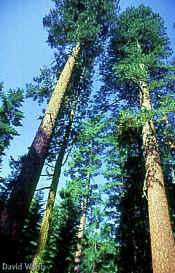 line as these are the most tolerant woody plants with regard to
heat, cold and aridity.
line as these are the most tolerant woody plants with regard to
heat, cold and aridity.
Secondary Growth is the result of Lateral Meristems (Vascular Cambium & Cork Cambium). The word Cambium signifies the meristematic nature of these two. The plane of cell division in both is predominately Periclinal. This produces radial files of cells which increase the girth of the organ in which they occur.
The Vascular Cambium
is a continuation of the Procambium. However, it induces cambial activity in adjacent cells and thus
adds to its circumference. The Cork Cambium arises de novo (new) from
Parenchyma.
adjacent cells and thus
adds to its circumference. The Cork Cambium arises de novo (new) from
Parenchyma.
The Vascular Cambium produces Secondary Xylem (wood) and Secondary Phloem (inner bark).
Secondary Xylem
provides structural support but it also provides a conduit for the translocation of water
throughout the entire plant. The largest conifers are several hundred feet high and their
root systems are equally large if not of greater extent. The Tracheary
Elements in conifers are Tracheids. These serve the dual functions of
the secondary xylem but they represent a compromise in terms of both.Tracheid properties
differ depending on the environmental conditions under which they are formed. Tracheids
have a thicker wall and a narrower diameter if they are formed during periods of water or
temperature stress. The opposite occurs during times of plenty. The former are better for
support and the latter are better for conduction. Angiosperms
produce Vessel Members and Fibers
which are more specialized for conduction or support, respectively, and are thus more
efficient at both.
in conifers are Tracheids. These serve the dual functions of
the secondary xylem but they represent a compromise in terms of both.Tracheid properties
differ depending on the environmental conditions under which they are formed. Tracheids
have a thicker wall and a narrower diameter if they are formed during periods of water or
temperature stress. The opposite occurs during times of plenty. The former are better for
support and the latter are better for conduction. Angiosperms
produce Vessel Members and Fibers
which are more specialized for conduction or support, respectively, and are thus more
efficient at both.
Secondary Phloem
transports sucrose throughout the organism. Its Sieve Elements
are Sieve Cells. These have Sieve Pores in their walls. They
are lined with Callose and they are similar to sieve cells in seedless
vascular plants. Angiosperms have Sieve
Tube Members which are more efficient for conduction.
Callose and they are similar to sieve cells in seedless
vascular plants. Angiosperms have Sieve
Tube Members which are more efficient for conduction.
The Cork Cambium
(Phellogen) produces Cork (Phellem). Cork is commonly known as "outer bark".
This tissue is dead, except for the Phellogen and its immediate derivatives. The walls of
Cork Cells are impregnated with Suberin. This is a
hydrophobic material that is water-proof and pathogen-proof. It prevents excess water loss
and it also insulates living cells from the external environment. Some plants like Douglas
Fir and Ponderosa Pine have barks which
protect them from prairie fires. This allows them to survive in environments which are
hostile to their competitors.
barks which
protect them from prairie fires. This allows them to survive in environments which are
hostile to their competitors.
The Apical Meristems of Conifers are multicellular. They have much in common with the apical meristems of flowering plants. They do not have noticeable "Initials". The Shoot Apical Meristem has a prominent Quiescent Center which has been called the Central Mother Cell Zone. The Root Apical Meristem tends to be broad and all of the tissues of the Root Body and Root Cap are produced by the same Meristem Proper.
| Most Conifers have Needle-like or Scale-like Leaves | |
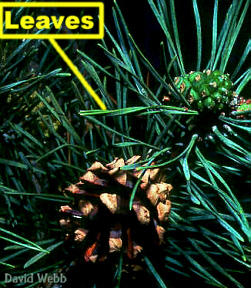 |
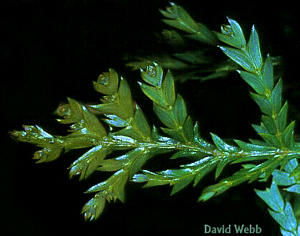 |
| Needle-like Leaves of Pinus | Scale-like Leaves of Cypress |
Conifer Leaves have many adaptations that equip them to deal with dry, hot and cold environments.
They have a reduced Lamina (blade).
Pinus monophylla has a cylindrical shape. This give it a small Surface Area/Volume ratio. This means that evaporation will be minimized compared to a flat blade.
If the separate needles of 2-5 needle Pines are viewed together they form a cylinder.
The Epidermis has a thick Cuticle & its walls may be Lignified.
Stomata are "sunken".
A Sclerified Hypodermis (layer(s) below Epidermis) is usually present.
Closely spaced Chlorenchyma
An Endodermis separates the Mesophyll & Vascular Bundle.
The Vascular Tissues are unbranched and reside in the center of the leaf.
Stems
| Cross section of a young Pinus stem: Note the Interrupted ring of Vascular Tissues | 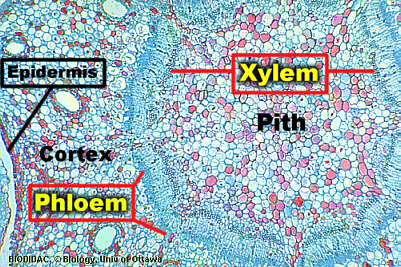 |
| Pinus stem after a period of Secondary Growth: The Secondary Xylem has stained Red. |  |
| Pinus Stem after two years of growth |  |
All Conifers produce Periderm. Periderm usually arises in the subepidermal Parenchyma. Several cells divide Periclinally and continue to divide this way. This results in radial files of cells which emanate from these Meristematic Cells which are called the Cork Cambium or Phellogen. The Phellogen tends to produce cells towards the outside of the Stem or Root. Meristematic activity spreads laterally until the entire circumference of the organ is encompassed. Cork Cells (Phellem) have Suberized walls and are dead at maturity. Suberin is waxy and prevents excess evaporation. It is almost indigestible by microbes and thus provides a barrier against pathogens. The absence of protoplasm in the dead cork cells deprives pathogens of any nutrients. It also insures that there are no Symplastic connections through which viruses might spread. Commercial Cork comes from the "Cork Oak". It has insulating properties because air is trapped within the individual cork cells. Consequently, the Periderm has insulating properties which lend some protection against temperature extremes in nature. The Periderm is an extremely important adaptation.
The Primary Root of Conifers is similar to what we have seen before. However, Conifer Roots have Secondary Growth. They have Secondary Vascular Tissues and Periderm. This allows them to expand over time and thus increase their ability to anchor the ever-increasing above ground biomass of the shoot system. It also allows them to persist for centuries in some cases. The Periderm has functions similar to the Periderm on aerial structures. Secondary Vascular Tissues also have the same primary functions as their aerial counterparts.
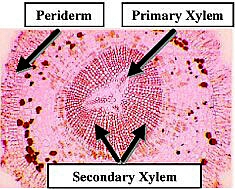 |
 |
| Cross Section of a Conifer Root with Secondary Growth |